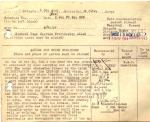Michael Hughs Charles Wriothesley Allan, DSO, ED was born and raised in Victoria, BC. He attended Oak Bay High School and Brentwood College. He graduated from the Royal Military College in 1939 receiving a Diploma with Honours. He had a Lewis Gun badge and an Athletic Badge for soccer. He was commissioned into the Royal Canadian Engineers and volunteered immediately for the Canadian Active Service Force. He deployed to the United Kingdom soon after. He took command of the 8th Field Squadron in February 1944 and led them through Normandy, the Low Countries and to Germany where he was wounded.
The following extract from Green Route Up, 4th Canadian Armoured Divisional Engineers from Caen to Wilhemshaven, tells the story of an early morning attack on his Squadron HQ:
"In the afternoon of 9 April 1945, HQ Troop of the 8th Field Squadron harboured in a field behind a house and barn in the town of SOGEL. Those of the Troop who did not sleep in their vehicles or tents bedded down in the barn. Civilians in the vicinity tried to please Troop personnel with offers of drinks and beds.
Visibility was poor due to a heavy mist and everyone was used to hearing their own troops discharging captured enemy weapons. This prevented early detection of the attack which came at 0815 hrs. So swiftly was it pressed home that only 15 of the 50 all ranks present in the lines at the time were able to procure their weapons. On seeing about 20 Germans fanning out to the flank, one party took up firing positions behind a brick pile facing them. Capt Greenhalgh, Sgt Hildur, Sgt Hickman and the SSM took parties to firing positions giving all round protection to the Troop area. Sig Coppen and Spr Elmer were wounded while manning their Bren guns.
Maj Allan arrived while the attack was in progress and was immediately shot in the neck by a sniper. Spr Faultless and L/Cpl Stubbard evacuated Maj Allan under fire in a jeep. Capt Conn, the dental officer and SQMS Howarth evacuated Spr Screda in the dental clinic vehicle. By this time medical men from the ADS nearby were roused, gathered their weapons, and lent the sappers a hand until 1030 hrs when the besieged party was relieved by the arrival of tanks. One of the tanks fired a round into a house held by 8 Fd Sqn but fortunately, no casualties resulted from this mistake. After the attackers were driven off the surrounding houses were checked and large supplies of automatic weapons and ammunition were found. Some of the members of HQ Troop of the 8th Field Squadron who deserved commendation for outstanding bravery are: Lt Zimmerman who effectively manned a Bren gun until fatally wounded, Cpl Parker who was fired on with a bazooka and immediately afterwards rushed by three Germans whom he killed with his Sten, Spr Faultless, L/Cpl Stubbard, SQMS Howarth and the dental personnel who evacuated casualties under fire, SSM Salkus, Sgt Hickman and Sgt Hildur who successfully directed the defence of the harbour.
Remustering took place immediately after and it was found that Maj Allan was seriously wounded, Capt Greenhalgh killed, Lt Zimmerman wounded (died later) and three ORs were killed and three wounded."
On returning to duty he was assigned the role of Commander Royal Engineers, 5th Canadian Armoured Division at the end of the war. After the war, he returned to Canada and pursued a career in engineering. He settled in Victoria and worked for BC Hydro for several years. He died at the Royal Jubilee Hospital on 13 August 1993 at the age of 72 years. Besides the DSO, he was also awarded the Canadian Efficiency Decoration on 30 June 1952.
Return to Sapper Gallantry in the Scheldt
During the Operation SWITCHBACK aimed at clearing the Breskens Pocket, the 4th Canadian Armoured Division engineers provided critical support to the 3rd Canadian Infantry Division. After hard and brutal fighting starting with the initial assaults across the Leopold Canal, the 7th Infantry Brigade had consolidated their bridgehead and started to breakout. By 12 October, the Canadian Scottish had forced their way out of the bridgehead and were in control of the Maldegem-Aardenburg road. The sappers' main tasks remained to establish and maintain routes forward through the flooded polders in support of the fight.
Using the improvised floating bridge built earlier by the 8th Field Squadron, 120-foot Class 40 Bailey Bridges were put across both the Leopold and Dérivation Canals the following day by the 8th and 9th Field Squadrons with assistance for the 31st Field Company. Major M. H. C. W. Allan of the 8th Field Squadron had done the reconnaissance for both bridges and remained on the forward site until both bridges were opened to traffic was awarded the Distinguished Service Order. Almost as soon as the bridges opened, the two squadrons packed up and re-deployed east of the 2nd Division area to support the 4th Division’s move to the east of Antwerp towards the Beveland Peninsula.


